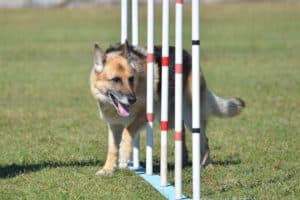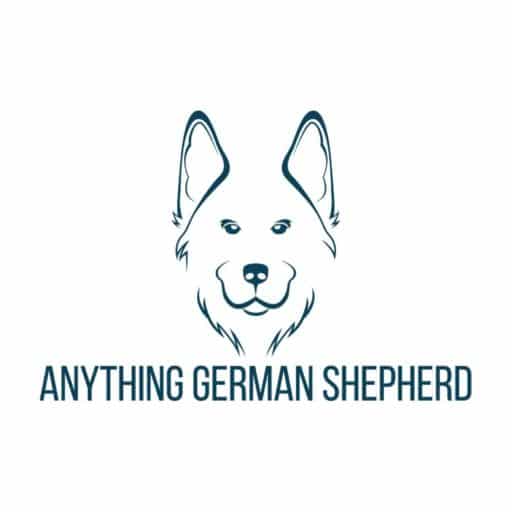How Much To Feed A German Shepherd Puppy For Best Results? Feeding Chart And Guide
When you bring a new German Shepherd puppy home for the first time, how do you prepare?
Knowing how much to feed a German Shepherd puppy is not an exact science.
However, various models support feeding your 8-week-old German Shepherd pup about 2 cups of dog food daily at the age of two to three months.
Once your pup hits 16 weeks, food intake jumps to approximately four cups a day, spread over two to four meals. Your puppy’s metabolism will mature and slow to adult German Shepherd levels around nine months of age.
At this time, you’ll start feeding it five to six cups of solid food per day, or about 1300 calories for a 60-pound dog.
We address three methods to determine how much to feed a German Shepherd puppy. We also cover why concerns other than basic nutrition are important for growing puppies.
Why Do You Feed A German Shepherd Puppy?
The two most obvious goals of feeding your German Shepherd are for health and growth.
German Shepherd Feeding Chart and Guide
Please note that this is a general feeding guide, and you should always consult with your veterinarian for specific dietary recommendations for your German Shepherd dog, as their nutritional needs can vary based on age, size, activity level, and health status. German Shepherd puppies need more food in smaller portions, while adults need fewer meals but can handle bigger portions. This feeding chart and guide show you how much food to feed your dog at different stages of their life.
| Age | Meal Frequency | Portion Size | Total Daily Amount |
|---|---|---|---|
| Puppy (2-4 months) | 3-4 meals/day | 1/2 to 1 cup per meal | 2-4 cups per day |
| Puppy (4-6 months) | 3 meals/day | 1 to 1 1/2 cups per meal | 3-4.5 cups per day |
| Puppy (6-12 months) | 2 meals/day | 1 1/2 to 2 cups per meal | 3-4 cups per day |
| Adult (1-7 years) | 1-2 meals/day | 2 to 3 cups per meal | 2-6 cups per day |
| Senior (7+ years) | 1-2 meals/day | 1 1/2 to 2 1/2 cups/meal | 3-5 cups per day |
Remember that this food chart is just an approximate guideline. Every dog is different. You should adjust the portions based on your dog’s individual needs, monitor their weight and body condition, and adapt the feeding schedule to their lifestyle. Always ensure that fresh water is available to your dog, and consider any specific dietary requirements or preferences your dog may have.
Feeding Guidelines for German Shepherds
- Total Daily Amount: Calculate the total daily amount by multiplying the portion size by the number of meals. For example, an adult dog may need 2-6 cups per day, depending on its specific needs.
- Water: Always provide fresh water for your German Shepherd. Hydration is crucial for their well-being.
- Monitor Weight: Keep an eye on your dog’s weight and body condition. Adjust their food portions as needed to maintain a healthy weight.
- Consult a Veterinarian: Every dog is unique, so consult your veterinarian for personalized feeding recommendations, especially if your dog has specific health concerns or dietary needs.
By following these guidelines, you can help ensure your German Shepherd gets the right nutrition for their age and lifestyle, promoting their overall health and well-being.
How Does Diet Affect The Health of Growing Shepherds?
Recently it has come to light that a proper diet for puppies does more than prevent malnutrition. As part of this proper diet, there are many things that should never be fed to German Shepherds.
Orthopedic Problems
Many orthopedic problems, such as hip and elbow dysplasia, have a strong hereditary component. However, people often discount the role of diet in bone developmental issues.
There’s a clear link between obesity in puppies and the resulting exacerbation of hip, elbow, and back problems.
However, your German Shepherd pup doesn’t have to be overweight to suffer a myriad of health challenges.
Merely creating an oversized puppy, as is often the case for show animals and people fixated on large dogs, can lead to several painful disorders:
- Hip dysplasia
- Elbow dysplasia
- Panosteitis – Generalized inflammation of the long bones in puppies; common in German Shepherds.
- Wobbler’s – More common in Great Danes and Dobermans, Wobblers is a condition whereby the spinal canal is too narrow, causing neurologic instability.
Overnutrition and over-supplementation of certain vitamins and minerals lead to paradoxical malnutrition of the bone and, subsequently, improper development.
Nutritional experts have modified their recommendations regarding the diets of large-breed dogs.
The Importance of Puppy Food
Many nutritionists and veterinarians advocate feeding German Shepherds and other large-breed puppies an adult or professionally formulated homemade diet to limit the occurrence and severity of developmental problems.
Pet food manufacturers have caught onto the concept of overnutrition in puppies, and most carry special diets for large-breed puppies.
Some argue for additional vitamin and mineral supplementation for puppies – we recommend working with a professional to formulate a diet that limits the growth rate and your puppy’s size during the early months.
Also, do not supplement your puppy with vitamins, minerals, or proteins without veterinarian direction – their excessive use will disrupt bone and cartilage growth and harm the growth plates.
Limiting calories and slowing your puppy’s growth rate in the first eight months of their life will not affect their mature size in any way.

How Much To Feed Your German Shepherd Puppy?
How To Know How Much Food to Feed?
The most pressing questions you probably have about your new puppy are how much to feed a German Shepherd and how often – let’s go over a few things to consider.
Many people use the food bag as a starting point to decide if they are feeding their dogs too much or too little food. However, a label on commercial food is one of the easiest ways to overfeed your growing large breed puppy.
Dog food labels may raise feeding guidelines by up to 25% to ensure the diet meets or exceeds NRC (Nutritional Research Council) requirements.
It’s more accurate and healthier for your puppy if you calculate and measure meals yourself.
Tracking Weight
Feeding your puppy involves regularly evaluating and tracking their weight. You should be able to assess how close your pup is to its ideal weight just by looking at it.
Weight charts are useful guides, but they don’t account for an individual’s variations from the norms. Also, don’t forget to include treats in your calculations for daily food allowances!
If you give a lot of treats during training, for example, you need to account for it by decreasing meal sizes according to your pup’s weight or body condition.
Assessing Body Condition
Drake Center for Veterinary Care uses a body scoring system modified from Purina’s charts and other sources.
- Silhouette from the side – a slight tuck. Pat the ribcage where the abdomen slightly lifts towards the hips. Note that some breeds don’t have an abdominal tuck, but the German Shepherd does.
- From above – Clear waist; should see an hourglass shape from rib cage to hips
- When you palpate – You should feel the ribs under a thin layer of fat without having to prod very hard.
Puppies will vary in their body scores and may change rapidly within a few days. Pups often lose their abdominal tuck right after a meal.
Puppies under 16 weeks old commonly have a pot-bellied appearance without much abdominal tuck.
Persistent abdominal distension could indicate intestinal worms, so be sure to check in regularly with a veterinarian during your pup’s first six months.
It’s difficult to keep growing puppies at a specific body score, but it’s always better that they be slightly underweight or even thin rather than overweight.
Thin dogs will show more visibility of ribs, waist, and pelvis without appearing emaciated or unhealthy.
If your puppy eats well but fails to grow or gain sufficient weight, consult a medical professional.
German Shepherds can be susceptible to rare cases of pituitary gland dwarfism or a deficiency of enzyme production from the pancreas.

Volume
Determining the right amount to feed your German Shepherd puppy can be crucial. The easiest way to figure it out is by considering how many cups they need in a day and dividing it by the number of feedings. You can also adjust the volume based on how your puppy’s body condition changes from week to week.
German Shepherd puppies, typically from 16 weeks of age to around nine months or a year, generally consume about four cups of food daily, regardless of their weight. This volume accounts for the higher caloric requirements of a growing young dog. Once your Shepherd reaches nine months, your focus shifts more to their weight and activity level. For instance, German Shepherds over a year old might require as much as five to eight cups of dog food. However, it’s important to note that some references use weight rather than age to determine the right amount to feed your pup.
Puppies weighing between 15 to 20 pounds might consume around one cup of food daily, while dogs over 100 pounds may need five cups of kibble plus an additional half a cup for every extra 20 pounds. Keep in mind that more active German Shepherds may require more food, so it’s essential to make adjustments based on their body scoring. Finding the right balance is crucial for keeping your beloved German Shepherd healthy and happy.
Calories
Calculating your puppy’s caloric requirements is the most accurate means to determine how much to feed it. You can estimate the volume to feed your German Shepherd pup once you find the conversion rate.
Dry dog food bags and wet food cans usually have the kilocalorie equivalence of each cup of the product.
If you feed your dog a raw or homemade diet, you’ll have to figure out the caloric content of each ingredient you use.
To determine the ideal caloric range of requirements for your puppy, it’s helpful to know the anticipated adult weight.
The number of calories you feed your Shepherd depends on how close to the adult weight they are.
- Shortly after weaning: 11 to 17 pounds (0 to 20% of adult weight) >>10 calories per 10 lbs body weight
- 4 to 5 months old (40 to 50% of adult weight) >> 50 to 100 calories per 10 lbs body weight
- 6 or 7 months old (50 to 60% of adult weight) >> 40 to 50 calories per 10 lbs body weight
- 7 to 9 months old (60 to 80% of adult weight) >> 30 to 40 calories per 10 lbs body weight
- over 9 months old >>20 to 25 calories per 10 lbs body weight
Caloric requirements, again, vary depending on the individual, and you still need to be aware of your puppy’s changing body condition.
The ‘When’: How Often Should You Feed Your German Shepherd?
If you have the added challenge of acquiring your Shepherd pup when they’re under six weeks of age, it may be worth preparing a mash of kibbles that can be given every few hours.
Once your puppy reaches six weeks old, you may still have to feed it a mash but can decrease meals to four per day. German Shepherd puppies between the ages of 12 and 16 weeks can eat three to four times daily, while most dogs over four months of age decrease to a frequency of two to three times daily.
Although many owners are eager to decrease their pup’s mealtimes to one or two times daily for convenience, there are a couple of important reasons not to do this.
Bathroom Schedule
It’ll require a few months to completely housetrain your puppy. Young puppies need to ‘go to the potty’ pretty frequently. Centering a few potty breaks around meals that stimulate their intestinal tracts helps develop consistent habits.
GDV
Your German Shepherd puppy will begin to develop a deeper chest combined with significant size by four to six months of age.
Both physical characteristics put your puppy at additional risk of gastric dilatation and volvulus compared to smaller breeds.
Four months is the age at which most pups will see a significant increase in their meal sizes. Studies have linked large meals with GDV, or bloat, life-threatening distension, and rotation of the stomach.
Increasing the number of feedings greatly reduces the incidence of GDV. We recommend at least two meals a day for your dog, even as your Shepherd approaches adulthood.
When feeding your German Shepherd, it’s essential to consider their age and nutritional requirements. A German Shepherd puppy feeding chart, as well as guidelines for their diet, can be valuable tools in ensuring that you’re providing the right amount of food for your growing pup.
Providing them with too much or too little food can have health implications, so it’s crucial to understand how much to feed your German Shepherd at different stages of its development. By giving the right care and attention to their feeding schedule, you’ll help keep your beloved dog healthy and happy.
Our YouTube Video On Feeding German Shepherd Puppies
Conclusion
Meals are extremely important for your German Shepherd puppy’s health, well-being, and vitality.
How much to feed a German Shepherd puppy is part of a broader equation that includes avoiding overfeeding, calculating portion sizes, and scheduling appropriate mealtimes.
Eight Weeks
Note that the puppy doesn’t have much of an abdominal tuck at this age. However, a fat or pudgy puppy is not a look anyone should encourage.
The puppy may appear to be in good shape, but you need to feel the ribs to be certain.
Four Months
You can really start to see the amount the pup has grown compared to the eight-week-old puppy!
To get a better idea of what to expect with a young GSD, feel free to watch this video!
It illustrates the rapid growth rate of the German Shepherd and touches on diets as well.
One final note that we’d like to leave you with is that the enhancement of German Shepherd growth through nutritional excesses is neither necessary nor desirable.
Recommended reading
- 6 Best Dog Food For German Shepherd
- 7 Best Food For German Shepherd To Gain Weight
- 6 Best Dog Food For EPI German Shepherd
FAQ
How much should I feed my German Shepherd?
The amount of food you should feed your German Shepherd depends on their age, weight, and activity level. Refer to a German Shepherd feeding chart to determine the appropriate amount for your dog.
How often should I feed my German Shepherd puppy?
German Shepherd puppies should be fed three to four times a day until they are around 6 months old. After that, you can reduce the frequency to twice a day.
What type of food should I feed my German Shepherd puppy?
It is best to feed your German Shepherd puppy a high-quality, specially formulated puppy food that is specifically formulated for large breed puppies. This ensures that they receive the proper balance of nutrients for their growth and development.
Can I feed my German Shepherd human food?
While it is okay to occasionally give your German Shepherd small amounts of certain human foods, it is important to avoid feeding them anything that can be harmful or toxic to dogs. Stick to high-quality dog food for their main diet.
How do I create a feeding schedule for my German Shepherd?
To create a feeding schedule for your German Shepherd, determine the appropriate amount of food based on their age and weight, and divide that into two or three meals per day. Stick to a consistent schedule to help maintain their digestion and overall well-being.
Should I feed my German Shepherd dry or wet food?
Both dry and wet food can be suitable for German Shepherds. It ultimately depends on your personal preference and your dog’s preferences. Some owners choose to feed a combination of both for variety.
How much food does a German Shepherd adult dog need?
The amount of food a German Shepherd adult dog needs can vary depending on their activity level and metabolism. It is generally recommended to feed them twice a day, with the total daily amount ranging from 3 to 4 cups of dry food.
Can I feed my German Shepherd a raw food diet?
While some owners choose to feed their German Shepherds a raw food diet, it is important to do thorough research and consult with a veterinarian to ensure that it is done correctly and provides all the necessary nutrients for your dog.




















